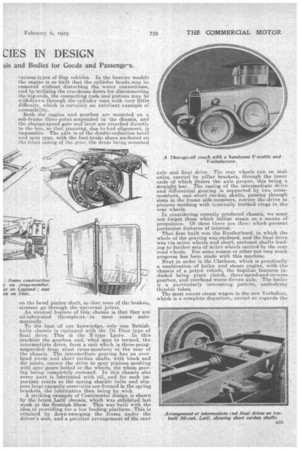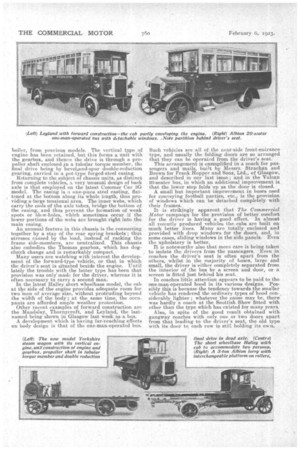THE LATEST . TE
Page 16

Page 17

Page 18

If you've noticed an error in this article please click here to report it so we can fix it.
CIES IN DESIGN
As Exemplified by the Most Recently Pro( sis and Bodies for Goods and Passenge-s.
IT Is ALWAYS difficult to know how to deal in an interesting manner with an article founded on points of design. A mere catalogue of modifications which have been effected and additions which have been made may be useful to the designer, but it does not appeal to the average user. For this-reason we have merely picked out features which show, or tend to show, the trend of thought and practice in
certain directions. :.
Dealing first with chassis, one of the most interesting innovations is the type of frame employed on the new 2-ton B.W. Straker-Squire model. In this frame, which is of channel-section pressed steel, the lower web of each side-member is extended at the front end for an appreciable distance and then turned over until it becomes, to all intents and purposes, also of channel-section, but, in this case, with the open side of the channel facing outwards. This provides an enormously stiff construction, on which is carried the engine and gearbox.
The extended portion of each side member is tapered off to the rear, so that the strength of the frame is not abruptly altered, for if this were the case, weaknesses would be apparent at the point where the change in strength occurred. In certain other vehicles, plates, resting on the lower webs of the frame side-members, are fitted into the channels, but the unit system described is most unusual. Of considerable interest is the new 2-ton H type Karrier chassis. In this the springing is particularly good, the rear springs being no less than 5 ft. between centres, whilst friction is reduced by fitting • wheels which are carried at front and rear on Skcfko ball bearings and Timken roller bearings respectively.
i A. very unusual feature s the anchoring of the transmission foot brake on a separate tubular crossmember some little distance behind the gearbox. This cross-member also supports the centre hearing of the two-piece propeller shaft with its four Hardy joints. The construction relieves the forward joints from the braking stresses, removes the risk of fracturing or straining the gearbox case through using it as an anchorage for the shoes, and permits a long ,wheelbase without an undulli long unsupported propeller shaft_ Another point in thiscjiassis is that the wheels are the new patent Shrewsbury and Challiner disc type, in which the discs are in compression radially and in tension circumferentially, giving a wheel which lit is 'practically impossible to disintegrate or work loose.
Another chassis of most unconventional type is the Watson. This is built to -carry 5+,-6i tons. The propeller shaft has Be Dion jaw-type universal joints, with dies of phosphor-bronze sliding in case-hardened steel jaws. The heavy combined radius and torque members form a-unit with the back axle, and act as supports for the transmission brake anchorage, this brake being situated immediately in front of the axle and behind the rear universal joints.
The axle is of the dual type, in which a solid square: steel member takes the load, whilst the gearing arid driving shafts are enclosed in what would, in an. ordinary chassis, be the axle easing. The final drivn is by pinions meshing with internal gear rings in the wheels.
This is one of the few examples Of internal-gear drive utilized on chassis of British manufacture. . Many 'features of interest are embodied in. the various types of Guy vehicles. In the heavier models the engine is so built that the cylinder heads may be removed without disturbing the water connections, and by utilizing the crankcase doors for disconnecting the big-ends, the connecting rods and pistons may be withdrawn through the cylinder tops with very little difficulty, which is certainly an excellent example of accessibility. Both the engine and gearbox are mounted on a sub-frame three-point-suspended in the chassis, and the change-speed gate and lever are attached directly to the box, so that jamming, due to had alignment, is impossible. The axle is of the double-reduction bevel and spur type, with the foot-brake shoes anchored on the front casing of the gear, the drum being mounted
on the bevel pinion shaft, so that none of the braking stresses go through the -Universal joints.
An unusual feature of Guy chassis is that they are oil-lubricated throughout—in most cases automatically.
To the best of our knowledge, only one Britishbuilt chassis is equipped with the De Dion type of final drive. This is the N-type Lacre. In this machine the gearbox and, what may. be termed, the intermediate drive, form a unit which is three-poiasuspended from stout cross-members at the rear of the chassis. The intermediate gearing has an overhead worm and short cardan shafts, with block and die joints, convey the drive to spur pinions meshing with spur gears bolted to the wheels, the whole gearing being completely enclosed. In this chassis also every part is lubricated with oil, and for such important points as the spring shackle bolts and slippers large capacity reservoirs are formed in the spring brackets, the lubrication then being by wick. A striking example of Continental design is shown by the latest Latil chassis, which was exhibited last week at the Scottish Show. This was built with the idea of providing for a low loading platform.This is attained by down-sweeping the frame under the driver's seat, and a peculiar arrangement of the rear axle and final drive. The rear wheels run on stub axles, carried by pillar brackets:, through the lower ends of which passes the axle proper, this being a Straight bar. The casing of the intermediate drive and differential gearing is supported by two crossmembers, and short cardan shafts, passing through slots in the frame side-members, convey the drive to pinions meshing with internally toothed rings in the rear wheels.
In considering recently produced chassis, we must not forget those which utilize steam as a means of propulsion. Of these there are three which present particular features of interest.
That first built was the Brotherhood, in which the whole of the gearing was enclosed, and the final drive was via mitre wheels and short-, enclosed shafts leading to further sets of mitre wheels carried by the rear road wheels. For some reason or other not very much progress has been made with this machine.
Next in order is the Clarkson, which is practically a combination of boiler and steam engine, with the chassis of a petrol vehicle, the familiar features included being plate clutch, three-speed-and-reverse gearbox, and overhead worm-driven axle. The boiler is a particularly interesting pattern, embodying thimble tubes.
The most recent steam wagon is the new Yorkshire, which is a complete departure, except as regards the
boiler, from previous models. The vertical typo of engine has been retained, but this forms a unit with the gearbox, and thence the drive is through a propeller shaft enclosed ,in a tubular torque member, the final drive being by beveleand-spur double-reduction gearing, carried in a pot-type forged-steel casing.
Returning to the subject of chassis units, as distinct from complete vehicles, a very 'unusual design of back axle is that employed on the latest Commer Car 30model. The easing is it one-piece steel casting, flattened at the bottom along its whole length, thus providing a iarge tensional area. The inner webs, which carry the ends of the axle tubes, bridge the bottom of the casing, and thus prevent the formation of weak spots or blow-holes, which sometimes occur if the lower portions of the webs are brought right into the main casing.
An unusual feature in this chassis is the connecting together by a stay of the rear spring brackets ; thus stresses caused by the load, instead of racking the frame side-members, are neutralized. This chassis also embodies the Thomas gearbox, which has dogclutch change and is remarkably compact.. Many users are watching with interest the development of the forward-type vehicle, or that in which the driver's seat is situated beside the engine. Until lately the trouble with the latter type has been that provision was onlimade for the driver, whereas it is often necessary to carry a second man. In the latest Halley short wheelbase model, the cab at the side of the engine provides adequate room for two 'men of average size, without protruding beyond the width of the body ; at the same time, the occupants are afforded ample weather protection. Other recent examples of forward construction are the Maudslay, Thornyeroft, and Leyland, the lastnamed being shown in Glasgow last week as a bus. A development which is having far-reaching effects on body design is that of the one-man-operated bus.
Such vehicles are all of the near-side front-entrance type, and usually the folding doors are so arranged that they can be operated from the driver's seat.. This arrangement is exemplified in a coach for passengers and mails, built by, Messrs. Strachan and Brown for Frank Hopper and Sons, Ltd., of Glasgow, and described in our last issue; and in the Vulcan 20-seater bus, in which an additional improvement is that the lower Step folds up as the door is closed. A small but important improvement in buses used for conveying football parties, etc., is the provision of windows which can be detached completely with their frames.
It is strikingly apparent that The Commercial Motor campaign for the Provision of better comfort for the driver is having a good effect. In almost all recently produced vehicles the cabs are built on much better lines. Many are totally enclosed and provided With drop windows for the doors, and, in some cases, sliding windows in the side panels. Even the upholstery is better. It is noteworthy also that more care is being taken to isolate the drivers from the passengers. Even in coaches the driver's seat is often apart from the others,. whilst in the majority of buses, large and small, the driver is either completely separated from the interior of the bus by a screen and door, or a screen is fitted just behind his seat.
In coaches little attention appears to be paid, to the one-man-operated hood in its various designs. Possibly this is because the tendency towards the smaller vehicle has rendered the ordinary types of hood cone, siderably lighter ; whatever the cause may be, there was hardly a coach at the Scottish Show fitted with other than the type which has existed for many years.
Also, in spite of the good result obtained with gangway coaches with only one or two doors apart from that leading to the driver's seat, the old type with its door to each row is still holding its own.




























